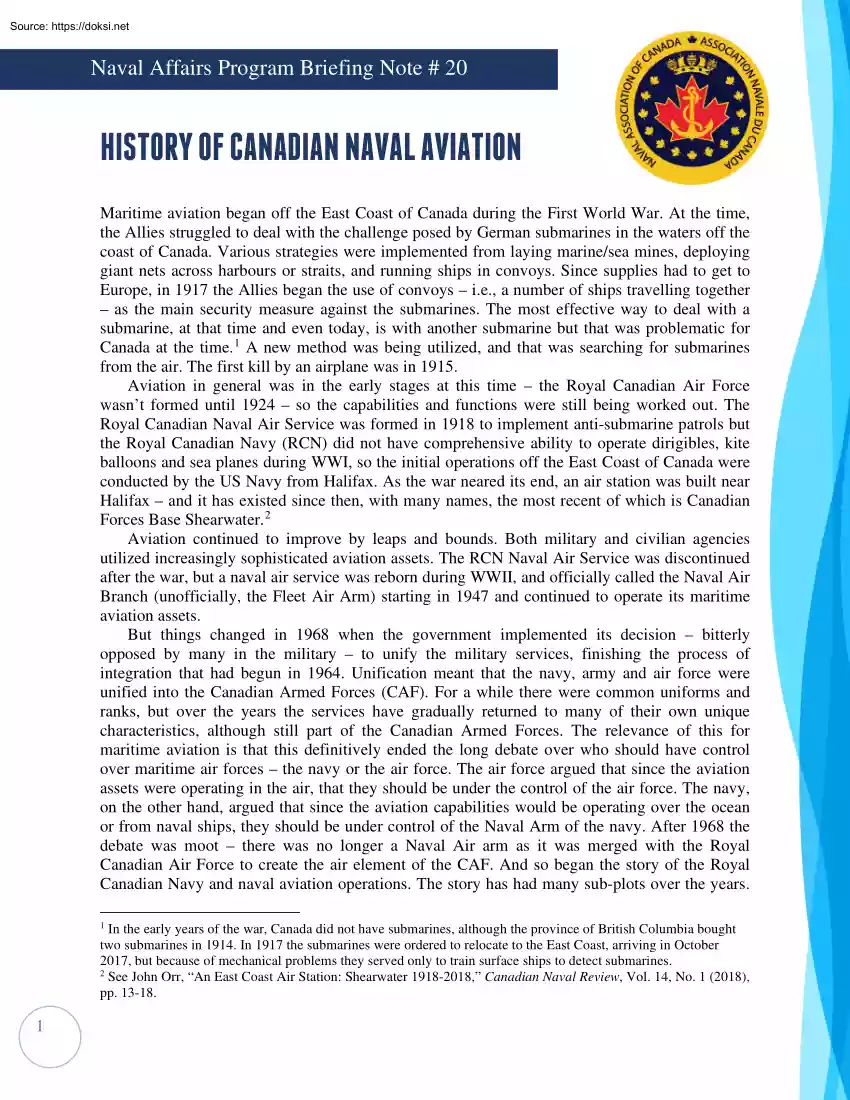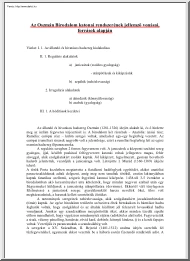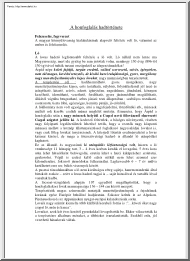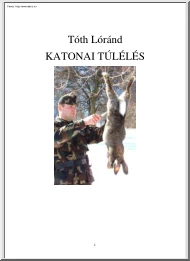Datasheet
Year, pagecount:2021, 3 page(s)
Language:English
Downloads:3
Uploaded:April 12, 2021
Size:637 KB
Institution:
-
Comments:
Attachment:-
Download in PDF:Please log in!
Comments
No comments yet. You can be the first!Most popular documents in this category
Content extract
Naval Affairs Program Briefing Note # 20 HISTORY OF CANADIAN NAVAL AVIATION Maritime aviation began off the East Coast of Canada during the First World War. At the time, the Allies struggled to deal with the challenge posed by German submarines in the waters off the coast of Canada. Various strategies were implemented from laying marine/sea mines, deploying giant nets across harbours or straits, and running ships in convoys. Since supplies had to get to Europe, in 1917 the Allies began the use of convoys – i.e, a number of ships travelling together – as the main security measure against the submarines. The most effective way to deal with a submarine, at that time and even today, is with another submarine but that was problematic for Canada at the time. 1 A new method was being utilized, and that was searching for submarines from the air. The first kill by an airplane was in 1915 Aviation in general was in the early stages at this time – the Royal Canadian Air Force wasn’t
formed until 1924 – so the capabilities and functions were still being worked out. The Royal Canadian Naval Air Service was formed in 1918 to implement anti-submarine patrols but the Royal Canadian Navy (RCN) did not have comprehensive ability to operate dirigibles, kite balloons and sea planes during WWI, so the initial operations off the East Coast of Canada were conducted by the US Navy from Halifax. As the war neared its end, an air station was built near Halifax – and it has existed since then, with many names, the most recent of which is Canadian Forces Base Shearwater. 2 Aviation continued to improve by leaps and bounds. Both military and civilian agencies utilized increasingly sophisticated aviation assets. The RCN Naval Air Service was discontinued after the war, but a naval air service was reborn during WWII, and officially called the Naval Air Branch (unofficially, the Fleet Air Arm) starting in 1947 and continued to operate its maritime aviation assets. But things
changed in 1968 when the government implemented its decision – bitterly opposed by many in the military – to unify the military services, finishing the process of integration that had begun in 1964. Unification meant that the navy, army and air force were unified into the Canadian Armed Forces (CAF). For a while there were common uniforms and ranks, but over the years the services have gradually returned to many of their own unique characteristics, although still part of the Canadian Armed Forces. The relevance of this for maritime aviation is that this definitively ended the long debate over who should have control over maritime air forces – the navy or the air force. The air force argued that since the aviation assets were operating in the air, that they should be under the control of the air force. The navy, on the other hand, argued that since the aviation capabilities would be operating over the ocean or from naval ships, they should be under control of the Naval Arm of the
navy. After 1968 the debate was moot – there was no longer a Naval Air arm as it was merged with the Royal Canadian Air Force to create the air element of the CAF. And so began the story of the Royal Canadian Navy and naval aviation operations. The story has had many sub-plots over the years 1 In the early years of the war, Canada did not have submarines, although the province of British Columbia bought two submarines in 1914. In 1917 the submarines were ordered to relocate to the East Coast, arriving in October 2017, but because of mechanical problems they served only to train surface ships to detect submarines. 2 See John Orr, “An East Coast Air Station: Shearwater 1918-2018,” Canadian Naval Review, Vol. 14, No 1 (2018), pp. 13-18 1 But despite the sub-plots and digressions, for 100 years maritime aviation has played an extremely valuable role in RCN operations. Although based on land, Canada has maritime aviation capability in the Maritime Patrol Aircraft. These are
fixed-wing (ie, airplanes) rather than rotary-wing (helicopters) aircraft and are operated by the Royal Canadian Air Force. Canada’s Maritime Patrol Aircraft are called the Auroras (CP-140), and they have been conducting maritime aviation missions since they were acquired in the 1980s. Their capabilities were primarily intended for anti-submarine warfare (ASW) off the coasts of Canada, but the aircraft also undertake maritime surveillance, fishing fleet surveillance, sovereignty patrols, and counter-drug and search-and-rescue missions. As well, the CP-140 is the only strategic Intelligence Surveillance and Reconnaissance (ISR) aircraft that Canada has, conducting long-range missions over land, water and coastal (littoral) areas. (For more on the tasks and capabilities associated with maritime aviation, see Briefing Note #21.) These aircraft are getting on in years, and without a replacement on the horizon, have had to be updated. There are two programs to update them, the Aurora
Incremental Modernization Project (AIMP) to update the electronics and technology in the aircraft, and the Aurora Structural Life Extension Project (ASLEP) to upgrade the framework/body of the aircraft. It might surprise Canadians to learn that Canada once had aircraft carriers. 3 With aircraft carriers came the aircraft. In April 1950, the RCN took possession of 75 Avenger aircraft from the US Navy, which were fitted with anti-submarine warfare (ASW) equipment. The RCN retired the Avenger in 1956, in favour of the Tracker for anti-submarine patrols. In November 1955, the RCN took possession of the F2H3 Banshee all-weather jet fighter, which was flown from the flight deck of Canada’s aircraft carrier, HMCS Bonaventure, and from bases on land. But RCN carrier-based naval aviation began to decline. In 1962, Canada did not take the opportunity to buy a US Navy aircraft carrier, and when the Banshees came up for replacement, the government chose not to replace them and the fighter
squadrons were disbanded. The RCN has not had aircraft carriers since HMCS Bonaventure was retired in 1970. 4 That means that the maritime air asset most associated with the RCN has been helicopters – it should be noted that the first ASW helicopter squadron was formed aboard an RCN aircraft carrier, HMCS Magnificent, in 1955. Starting in the late 1950s and early 1960s, the RCN began developing the idea of operating helicopters from smaller surface ships. It was a great idea, but it is more difficult to do than it appears at first. Taking off from the ship is not the problem, landing and securing the helicopter is the problem. It might be easy to land the helicopter on a relatively small ship in the ocean if the ocean was solid and unmoving (like land). But oceans aren’t solid and unmoving – there are waves and winds. Landing a helicopter safely on a ship that is moving up and down and side to side, amid strong winds, is not an easy feat. If you’re doing it at night, that adds
another element It took many years to develop a haul-down system that would grab the helicopter as it approaches the landing pad and stop it from sliding off, or otherwise damaging itself, the crew members, or the ship. The system that was developed by Canada and put into use in 1967 – the 3 In total, Canada had five aircraft-carriers: HMS Nabob, commissioned March 1943, Canadian manned but commissioned as Royal Navy (RN) ship, paid off September 1944; HMS Puncher, commissioned February 1944, Canadian manned but commissioned as RN ship, paid off January 1946; HMCS Warrior, commissioned January 1946, originally HMS Warrior of the RN but officially it was the first RCN carrier, paid off 23 March 1948; HMCS Magnificent, commissioned April 1948, paid off June 1957; and HMCS Bonaventure, commissioned January 1957, originally HMS Powerful of the RN, paid off July 1970. 4 For more information on this see Bruce Forsyth, “The Rise and Fall of the Royal Canadian Navy’s Fleet Air Arm,”
available at https://militarybruce.com/the-royal-canadian-naval-air-service-the-fleet-arm/ 2 Helicopter Hauldown and Rapid Securing Device, known as the ‘beartrap’ – was revolutionary and has been adopted in similar forms by other navies. Getting helicopters incorporated into the RCN wasn’t just about figuring out how to take off and land, there were other elements that had to be sorted out. For example, there had to be new members of the crew who were responsible for flying and maintaining the helicopters. So, the ships had to incorporate a helicopter detachment – a HELAIDET detachment, which could be up to 20 personnel – made up of the crew that flies the helicopter and the crew that launches, recovers and maintains it. As well, the ships themselves had to be restructured and various trials had to be conducted to get the balance correct and identify the design changes necessary. In the early 1960s, the St Laurent-class destroyers were upgraded to destroyer-helicopter
vessels, complete with helicopter flight-decks, making the RCN the first navy to use helicopters on small surface ships. And new ships that were built were henceforth designed to accommodate helicopters. In addition to the flight-deck, it was necessary to build a hangar in which the helicopters could be kept. Operations at sea are very different than those over land. Because operating at sea involves constant moisture and salt, corrosion is a real problem. The helicopters cannot be left outside exposed to the elements or they corrode quickly. Most Canadians will have heard of the Sea King (CH-124) helicopter which operated with the RCN for many years. These helicopters were acquired by Canada in the 1960s They undertook numerous roles and missions for the Royal Canadian Navy. 5 In the 1980s, the government announced that it was going to replace the Sea Kings with the EH-101 helicopter. Following an election and change of government in 1993, however, this plan was cancelled. The Sea
Kings carried on. A contract was signed in 2004 for a replacement helicopter and, at last after more than 50 years, the Sea Kings were retired in 2018. Starting in 2015 the RCAF began receiving the Cyclone (CH-148) helicopter and it continues to accept the helicopter into the RCAF. (Briefing Note #21 discusses the capabilities and tasks of the new helicopters) While the adoption of maritime aviation has improved the effectiveness of Canadian naval forces, it has not come without major changes to the fleet. But there is no way navies would go back to operating without aviation assets. They extend the reach and the sightlines of a navy and provide absolutely fundamental capabilities to modern navies. The future will definitely contain aviation assets at sea – as long as there are navies, there will be a need for maritime aviation to go with them. 5 See Jeff Tasseron, “Sailing to Byzantium: A Eulogy for the Sea Kings,” Canadian Naval Review, Vol 15, No. 1 (2019), pp. 5-10 3
formed until 1924 – so the capabilities and functions were still being worked out. The Royal Canadian Naval Air Service was formed in 1918 to implement anti-submarine patrols but the Royal Canadian Navy (RCN) did not have comprehensive ability to operate dirigibles, kite balloons and sea planes during WWI, so the initial operations off the East Coast of Canada were conducted by the US Navy from Halifax. As the war neared its end, an air station was built near Halifax – and it has existed since then, with many names, the most recent of which is Canadian Forces Base Shearwater. 2 Aviation continued to improve by leaps and bounds. Both military and civilian agencies utilized increasingly sophisticated aviation assets. The RCN Naval Air Service was discontinued after the war, but a naval air service was reborn during WWII, and officially called the Naval Air Branch (unofficially, the Fleet Air Arm) starting in 1947 and continued to operate its maritime aviation assets. But things
changed in 1968 when the government implemented its decision – bitterly opposed by many in the military – to unify the military services, finishing the process of integration that had begun in 1964. Unification meant that the navy, army and air force were unified into the Canadian Armed Forces (CAF). For a while there were common uniforms and ranks, but over the years the services have gradually returned to many of their own unique characteristics, although still part of the Canadian Armed Forces. The relevance of this for maritime aviation is that this definitively ended the long debate over who should have control over maritime air forces – the navy or the air force. The air force argued that since the aviation assets were operating in the air, that they should be under the control of the air force. The navy, on the other hand, argued that since the aviation capabilities would be operating over the ocean or from naval ships, they should be under control of the Naval Arm of the
navy. After 1968 the debate was moot – there was no longer a Naval Air arm as it was merged with the Royal Canadian Air Force to create the air element of the CAF. And so began the story of the Royal Canadian Navy and naval aviation operations. The story has had many sub-plots over the years 1 In the early years of the war, Canada did not have submarines, although the province of British Columbia bought two submarines in 1914. In 1917 the submarines were ordered to relocate to the East Coast, arriving in October 2017, but because of mechanical problems they served only to train surface ships to detect submarines. 2 See John Orr, “An East Coast Air Station: Shearwater 1918-2018,” Canadian Naval Review, Vol. 14, No 1 (2018), pp. 13-18 1 But despite the sub-plots and digressions, for 100 years maritime aviation has played an extremely valuable role in RCN operations. Although based on land, Canada has maritime aviation capability in the Maritime Patrol Aircraft. These are
fixed-wing (ie, airplanes) rather than rotary-wing (helicopters) aircraft and are operated by the Royal Canadian Air Force. Canada’s Maritime Patrol Aircraft are called the Auroras (CP-140), and they have been conducting maritime aviation missions since they were acquired in the 1980s. Their capabilities were primarily intended for anti-submarine warfare (ASW) off the coasts of Canada, but the aircraft also undertake maritime surveillance, fishing fleet surveillance, sovereignty patrols, and counter-drug and search-and-rescue missions. As well, the CP-140 is the only strategic Intelligence Surveillance and Reconnaissance (ISR) aircraft that Canada has, conducting long-range missions over land, water and coastal (littoral) areas. (For more on the tasks and capabilities associated with maritime aviation, see Briefing Note #21.) These aircraft are getting on in years, and without a replacement on the horizon, have had to be updated. There are two programs to update them, the Aurora
Incremental Modernization Project (AIMP) to update the electronics and technology in the aircraft, and the Aurora Structural Life Extension Project (ASLEP) to upgrade the framework/body of the aircraft. It might surprise Canadians to learn that Canada once had aircraft carriers. 3 With aircraft carriers came the aircraft. In April 1950, the RCN took possession of 75 Avenger aircraft from the US Navy, which were fitted with anti-submarine warfare (ASW) equipment. The RCN retired the Avenger in 1956, in favour of the Tracker for anti-submarine patrols. In November 1955, the RCN took possession of the F2H3 Banshee all-weather jet fighter, which was flown from the flight deck of Canada’s aircraft carrier, HMCS Bonaventure, and from bases on land. But RCN carrier-based naval aviation began to decline. In 1962, Canada did not take the opportunity to buy a US Navy aircraft carrier, and when the Banshees came up for replacement, the government chose not to replace them and the fighter
squadrons were disbanded. The RCN has not had aircraft carriers since HMCS Bonaventure was retired in 1970. 4 That means that the maritime air asset most associated with the RCN has been helicopters – it should be noted that the first ASW helicopter squadron was formed aboard an RCN aircraft carrier, HMCS Magnificent, in 1955. Starting in the late 1950s and early 1960s, the RCN began developing the idea of operating helicopters from smaller surface ships. It was a great idea, but it is more difficult to do than it appears at first. Taking off from the ship is not the problem, landing and securing the helicopter is the problem. It might be easy to land the helicopter on a relatively small ship in the ocean if the ocean was solid and unmoving (like land). But oceans aren’t solid and unmoving – there are waves and winds. Landing a helicopter safely on a ship that is moving up and down and side to side, amid strong winds, is not an easy feat. If you’re doing it at night, that adds
another element It took many years to develop a haul-down system that would grab the helicopter as it approaches the landing pad and stop it from sliding off, or otherwise damaging itself, the crew members, or the ship. The system that was developed by Canada and put into use in 1967 – the 3 In total, Canada had five aircraft-carriers: HMS Nabob, commissioned March 1943, Canadian manned but commissioned as Royal Navy (RN) ship, paid off September 1944; HMS Puncher, commissioned February 1944, Canadian manned but commissioned as RN ship, paid off January 1946; HMCS Warrior, commissioned January 1946, originally HMS Warrior of the RN but officially it was the first RCN carrier, paid off 23 March 1948; HMCS Magnificent, commissioned April 1948, paid off June 1957; and HMCS Bonaventure, commissioned January 1957, originally HMS Powerful of the RN, paid off July 1970. 4 For more information on this see Bruce Forsyth, “The Rise and Fall of the Royal Canadian Navy’s Fleet Air Arm,”
available at https://militarybruce.com/the-royal-canadian-naval-air-service-the-fleet-arm/ 2 Helicopter Hauldown and Rapid Securing Device, known as the ‘beartrap’ – was revolutionary and has been adopted in similar forms by other navies. Getting helicopters incorporated into the RCN wasn’t just about figuring out how to take off and land, there were other elements that had to be sorted out. For example, there had to be new members of the crew who were responsible for flying and maintaining the helicopters. So, the ships had to incorporate a helicopter detachment – a HELAIDET detachment, which could be up to 20 personnel – made up of the crew that flies the helicopter and the crew that launches, recovers and maintains it. As well, the ships themselves had to be restructured and various trials had to be conducted to get the balance correct and identify the design changes necessary. In the early 1960s, the St Laurent-class destroyers were upgraded to destroyer-helicopter
vessels, complete with helicopter flight-decks, making the RCN the first navy to use helicopters on small surface ships. And new ships that were built were henceforth designed to accommodate helicopters. In addition to the flight-deck, it was necessary to build a hangar in which the helicopters could be kept. Operations at sea are very different than those over land. Because operating at sea involves constant moisture and salt, corrosion is a real problem. The helicopters cannot be left outside exposed to the elements or they corrode quickly. Most Canadians will have heard of the Sea King (CH-124) helicopter which operated with the RCN for many years. These helicopters were acquired by Canada in the 1960s They undertook numerous roles and missions for the Royal Canadian Navy. 5 In the 1980s, the government announced that it was going to replace the Sea Kings with the EH-101 helicopter. Following an election and change of government in 1993, however, this plan was cancelled. The Sea
Kings carried on. A contract was signed in 2004 for a replacement helicopter and, at last after more than 50 years, the Sea Kings were retired in 2018. Starting in 2015 the RCAF began receiving the Cyclone (CH-148) helicopter and it continues to accept the helicopter into the RCAF. (Briefing Note #21 discusses the capabilities and tasks of the new helicopters) While the adoption of maritime aviation has improved the effectiveness of Canadian naval forces, it has not come without major changes to the fleet. But there is no way navies would go back to operating without aviation assets. They extend the reach and the sightlines of a navy and provide absolutely fundamental capabilities to modern navies. The future will definitely contain aviation assets at sea – as long as there are navies, there will be a need for maritime aviation to go with them. 5 See Jeff Tasseron, “Sailing to Byzantium: A Eulogy for the Sea Kings,” Canadian Naval Review, Vol 15, No. 1 (2019), pp. 5-10 3





